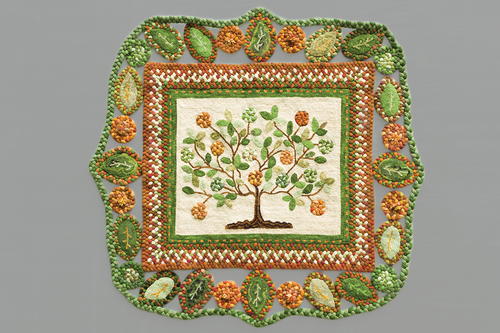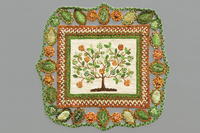Kris McDermet
Beautiful braiding, stunning hooking, exquisite art

Leaves of Grace, 46" x 43", hand-dyed and as-is various cuts of wool on linen. Designed, hooked, and braided by Kris McDermet, Drummerston, Vermont, 2010. Permission to use the Tree of Life Pattern was granted by Hancock Shaker Museum. It is based on the Tree of Life painting by Hannah Cahoon (1788-1864). Kris says, “The name, ‘Leaves of Grace,’ appeared one day in my thoughts. I told my sister-in-law, Beth McDermet, the title, and several days later she gave me a gold pin minus the back, in the shape of a leaf with the word Grace engraved on it. Our mother-in-law’s name was Grace Eleta McDermet.”
The hallmarks of a mature artist include having a readily identifiable, unique style and point of view. If someone looks at your work and can name you as the artist based on composition, color, technique, and subject, then you have entered your prime as an artist. Maturity is not a question of one’s age. Rather, in art, it is a reflection of significant time and effort that has gone into mastering one’s skills, tools, and materials; and more importantly, the ability to communicate one’s ideas and explorations through their medium.
Kris McDermet’s rugs, which combine techniques of traditional hooking and rug braiding, are a strong beacon indicating a mature artist’s sensibility; you know her rugs when you see them. No one else’s work resembles her efforts. Her art is unique, and her technique is precise, beautiful, flawless.
How did Kris develop her gorgeous, complex, and challenging technique of combining rug hooking and braiding? She first learned to braid in 1979 and her teacher, Isabel Clough, had been told by the now-closed Pembroke Massachusetts store, Braid Aid, that some people were adding a row of braid to their hooked rugs. Kris had not mastered hooking at that time (although she had been introduced to it by the mother of her friend, Vicki Simpson), but she made an oval-shaped needlepoint piece that she braided around, creating her first combination rug. Kris eventually created a hooked version of the oval, since needlepoint on the floor wasn’t ideal for standing up to foot traffic. Meanwhile, Isabel suggested that her students also take a class in rug hooking, and that teacher turned out to be Mary Sheppard Burton. Kris says, “I Ioved Mary’s home full of amazing hooked rugs, but I didn’t like hooking shaded pansies!”
Combining the techniques of hooking and braiding presented challenges. Kris could find no directions on joining techniques, so she experimented and refined her approach. “I pad and line the hooking so that it is the same thickness as the braid. Having experimented with different paddings, she now prefers wool batting. When something more rigid is required, she will use carpet padding. A finished piece intended for display gets lined (both the hooking and padding) with cotton. If it is destined for the floor, the lining is made from fine suit-weight wool. When asked about how to clean a lined and padded hooked rug, Kris advises, “You can unstitch a few inches of the lining, stick in the vacuum hose, and vacuum away.” This takes care of dirt that, in an unlined and unpadded rug, would have migrated through the textile to the floor below. Another challenge can be finding ways to hang her rugs. Kris says, “Combination rugs with open work borders can be hung using a pocket on the most stable part of the rug and several small tacks across the top of the open work border.”
Kris’s favorite backing for hooking is unbleached primitive linen. Wool, hand-dyed silk, crushed taffeta, and yarns with texture and sparkle comprise her favorite hooking materials; she uses a mixture of cuts in sizes 4, 5, and 6 for compositional elements, and 7 for backgrounds. Her braiding choices include wool, hand-dyed silk, crushed taffeta, and soft fabrics with sparkle. “I dye about 50 percent of what I hook and braid with. My friend Karen Kamenetsky convinced me to try silk by the yard from Dharma. My favorite wools are from Norma Batastini, Nancy Jewett, Mary Lee O’Connor, Stephanie Krauss, and Michelle Micarelli.” Kris has a favorite hook from Underhill Farm which she couples with an 8"x 10" portable lap frame from Ali Strebel. The frame collapses, making it easy to hook anywhere.
While Kris does not have a formal art background, she always loved making crafts. Her first career was an occupational therapist, working in home care and spinal cord injury. That career commenced the same year she started to hook and braid rugs. Kris finds inspiration in nature, travel, family, and friends. Just driving in her car and looking out the window and dreaming (safely, of course!) sparks ideas. She is also influenced by world events, community efforts, and the desire to create work that has a message. Kris has taken rug hooking classes from Jule Marie Smith, Sandra Brown, Michelle Micarelli, Linda Pietz, Tracy Jamar, Lori LaBerge, and Norma Batastini. “I appreciate that they have all let me be me,” Kris reports. “Michelle advised me to go brighter, and that was wonderful advice.”



